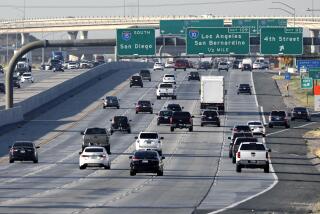Diamonds but Clearly Not Gems
- Share via
On a December morning last year, a patch of pea soup fog caused a horrific pileup on Interstate 5, closing all lanes into Sacramento at the beginning of the rush-hour commute.
The California Highway Patrol immediately detoured the blocked traffic onto a parallel freeway, California Route 99. And the first thing they did was to open the diamond lane to all traffic.
Why? “To increase the capacity, of course,” said one CHP official, who sounded somewhat incredulous at the question.
A more important question is, why is something so obvious to a CHP officer managing a traffic crisis utterly lost on the bureaucrats at Caltrans? California’s highway officials plan to double the number of diamond lanes clogging California freeways by 2015.
Meanwhile in New Jersey, transportation officials have come to an entirely different conclusion. On Nov. 30, they abolished the diamond lane restrictions along two heavily traveled routes. The relief was immediate. One commuter accustomed to diamond lane gridlock marveled, “This morning, it was zooming. Everybody was going along like a normal highway.”
This shouldn’t surprise anyone. A typical diamond lane carries only 7% of the traffic yet consumes 25% of the capacity on a four-lane freeway. This means the remaining 93% of traffic is deliberately crammed into 75% of the space.
Caltrans officials insist that diamond lanes encourage carpooling based on the false assumption that every car with more than one person is a carpool specifically created to take advantage of the lane.
The engineering studies on diamond lanes, including one from UC Berkeley’s Institute for Traffic Studies, make clear that the formation of new car pools is negligible and doesn’t begin to justify the deliberate gridlocking of the highway system.
A study of the Costa Mesa Freeway concluded that the diamond lane costs commuters the equivalent of 11,000 passenger trips per day. A quarter-century of experience backs up these studies.
Carpool lanes are supposed to increase ride sharing, but the percentage of car pools has remained constant over the years, despite the proliferation of carpool lanes. Neither are diamond lanes any help to the environment. Diamond lanes deliberately create gridlock, and gridlocked traffic produces 1.8 times the NOx (oxides of nitrogen) contaminants and 5.95 times the carbon contaminants per mile produced by traffic operating at peak efficiency.
Diamond lanes have, in fact, been an environmental disaster for California. They even defy their own logic. The diamond lane is supposed to give commuters an incentive to carpool by offering the vacant diamond lane as an alternative to the artificially congested lanes. But as commuters carpool, the diamond lane congests, the other lanes decongest and the incentive disappears. Even if they worked, they couldn’t work.
Diamond lanes simply provide the illusion of relief to the small percentage of traffic that can use them, while artificially gridlocking the 93% of the traffic that cannot. The most common defense of diamond lanes is that new lanes for regular traffic quickly fill up and that congestion ends up being as bad as before. In other words, California’s top transportation officials argue, “Don’t build more traffic lanes; people will use them.”
Our modern bureaucrats prefer to build transportation systems that people don’t use. It is a natural condition of human nature that the more we invest in our mistakes, the less we are willing to admit them.
Several years ago, a Caltrans official in a rare moment of candor explained the real purpose of the diamond lane. He said it was “to make life miserable for the single motorist.”
They have succeeded. Diamond lanes now clog virtually every major freeway artery in California. But diamonds don’t have to be forever, as New Jersey has proven.
More to Read
Sign up for Essential California
The most important California stories and recommendations in your inbox every morning.
You may occasionally receive promotional content from the Los Angeles Times.










